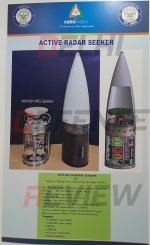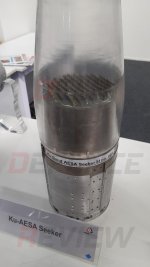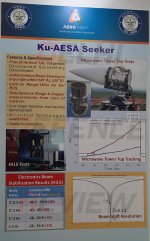You are using an out of date browser. It may not display this or other websites correctly.
You should upgrade or use an alternative browser.
You should upgrade or use an alternative browser.
So this thread should purely be for defence related technology india has so far developed and is going to develop in 5 year time frame . All images attached should be credited to respective owners . Contribute positively .
@Nilgiri @kumata please tag other interested member .
Special mention ,it should be more about subsystem than main platform
@Nilgiri @kumata please tag other interested member .
Special mention ,it should be more about subsystem than main platform
Seeing how it goes, I might just merge it with this thread:

 defencehub.live
defencehub.live
Or do you have something specific in mind to this one?
I just changed the title for now....to something shorter.

Defence Industry
Expert panel to help DRDO prepare for futuristic battles, defence needs DRDO chief G Satheesh Reddy has constituted a five-member committee and asked it to submit its report within 45 days...
 defencehub.live
defencehub.live
Or do you have something specific in mind to this one?
I just changed the title for now....to something shorter.
So this thread should purely be for defence related technology india has so far developed and is going to develop in 5 year time frame . All images attached should be credited to respective owners . Contribute positively .
@Nilgiri @kumata please tag other interested member .
Special mention ,it should be more about subsystem than main platform
It's a pleasure to read @Nilgiri 's topics. I hope so will yours.
Thanks matey ,hope you will not be disappointedIt's a pleasure to read @Nilgiri 's topics. I hope so will yours.
First topic is drdo work on BODY OF ROTATION gan aau .

Now this technology is truly a boon for aircraft . Not only it can help in wide band application like a single element acting as EW jammer and receiver like saab uses as per article , sometimes as communication antenna , or radar also . This will help on 360° active situational awareness to fighter aircraft , (here potential is for AMCA ) , which no 5th gen possess as now officially .
It is cost effective , much wideband , low power consumption .
Now why they need it instead of traditional array , so reason is cost and weight , now instead of multiple sensor , a single sensor will do the jon for you .

 www.saab.com
www.saab.com
Above link for similar system SAAB uses on gripen ng ew suite .
Now this technology is truly a boon for aircraft . Not only it can help in wide band application like a single element acting as EW jammer and receiver like saab uses as per article , sometimes as communication antenna , or radar also . This will help on 360° active situational awareness to fighter aircraft , (here potential is for AMCA ) , which no 5th gen possess as now officially .
It is cost effective , much wideband , low power consumption .
Now why they need it instead of traditional array , so reason is cost and weight , now instead of multiple sensor , a single sensor will do the jon for you .

Advanced innovation detected | Stories | Saab
The 2017 Saab Innovation Prize has gone to Dr. Henrik Holter for his invention of a new phased array antenna, which is central to the electronic warfare system of Gripen E.
Above link for similar system SAAB uses on gripen ng ew suite .
First topic is drdo work on BODY OF ROTATION gan aau .
Is there a DRDO paper referring to this?
Drdo don't share it officially , it's under development as of now , sill share if get across thatIs there a DRDO paper referring to this?
@Test7 maybe you would like to know about it .First topic is drdo work on BODY OF ROTATION gan aau .
View attachment 29430
Now this technology is truly a boon for aircraft . Not only it can help in wide band application like a single element acting as EW jammer and receiver like saab uses as per article , sometimes as communication antenna , or radar also . This will help on 360° active situational awareness to fighter aircraft , (here potential is for AMCA ) , which no 5th gen possess as now officially .
It is cost effective , much wideband , low power consumption .
Now why they need it instead of traditional array , so reason is cost and weight , now instead of multiple sensor , a single sensor will do the jon for you .

Advanced innovation detected | Stories | Saab
The 2017 Saab Innovation Prize has gone to Dr. Henrik Holter for his invention of a new phased array antenna, which is central to the electronic warfare system of Gripen E.www.saab.com
Above link for similar system SAAB uses on gripen ng ew suite .
Next post tomorrow
So next system is quite a innovative approach undertook by drdo .
The much discussed SMART missile .
Basically it's a supersonic missile which contains a topedo as a payload and releases it near submarine for long range kill from ground based system .
The missile is based on shaurya quasi ballastic missile with high supersonic speed to reduce interception time .
So what makes it special ??
So unlike traditional system worldwide , it has HUMONGOUS RANGE of 650 km , which can assure area denial capability .
Now question arises is how can it achieve that range and how is it practical to guide it with pin point accuracy .
So india employs a network of multiple sensor to do the task .
First component -earth observation satellites .
Second component -p8i Poseidon with a track range of 350 km and employing mpr , magnetic anomaly detector and sona buoy .
Third component - sea guardian drone .
Fourth component - the sea bed based sonar network india uses with association with USA and japan . This is MOST important as it is a long range solution , unlike surface sonar it distinguish target in background of open skies at top .
The much discussed SMART missile .
Basically it's a supersonic missile which contains a topedo as a payload and releases it near submarine for long range kill from ground based system .
The missile is based on shaurya quasi ballastic missile with high supersonic speed to reduce interception time .
So what makes it special ??
So unlike traditional system worldwide , it has HUMONGOUS RANGE of 650 km , which can assure area denial capability .
Now question arises is how can it achieve that range and how is it practical to guide it with pin point accuracy .
So india employs a network of multiple sensor to do the task .
First component -earth observation satellites .
Second component -p8i Poseidon with a track range of 350 km and employing mpr , magnetic anomaly detector and sona buoy .
Third component - sea guardian drone .
Fourth component - the sea bed based sonar network india uses with association with USA and japan . This is MOST important as it is a long range solution , unlike surface sonar it distinguish target in background of open skies at top .
Continuation ......So next system is quite a innovative approach undertook by drdo .
The much discussed SMART missile .
Basically it's a supersonic missile which contains a topedo as a payload and releases it near submarine for long range kill from ground based system .
The missile is based on shaurya quasi ballastic missile with high supersonic speed to reduce interception time .
So what makes it special ??
So unlike traditional system worldwide , it has HUMONGOUS RANGE of 650 km , which can assure area denial capability .
Now question arises is how can it achieve that range and how is it practical to guide it with pin point accuracy .
So india employs a network of multiple sensor to do the task .
First component -earth observation satellites .
Second component -p8i Poseidon with a track range of 350 km and employing mpr , magnetic anomaly detector and sona buoy .
Third component - sea guardian drone .
Fourth component - the sea bed based sonar network india uses with association with USA and japan . This is MOST important as it is a long range solution , unlike surface sonar it distinguish target in background of open skies at top .
The fourth component - it offer approx 100 km range for submarine tracking .
With all these systems in place , through data link , the SMART missile will get guidance for accuracy in near km , so that it can release the light weight torpedo at range of 10 kilometres (max range 19 km ) , for assured kill .
When launched in twin fire , it can give a assurance of atleast single hit at very long range .
Things to ponders about is its cost of operation , response time , usability , deployment on ships .
So as per cost , the whole missile +torpedo will be almost in range of any srbm , but can deal a huge blow with a single strike .
Second , response time , this won't be a issue for this system as it's target is a slow moving submarine and if it launched at safe distance of 500 km , target submarine can't travel 150 km so fast to evade a supersonic missile .
Deployment on ship in current form is not possible ,but a smaller version with lower range can be developed for this specific use .
What makes it go in this RnD section ?
Basically the whole set of complex network centric warfare used in this single system is unmatched by normal programme .
VIEWS AND INFO IS FROM DFI AND MEMBERS (SPECIAL MENTION -P_ KICKER )
Last edited by a moderator:
So india employs a network of multiple sensor to do the task .
This will be the part that needs lot of verification testing over the years coming up.
The torpedo itself final kill capability is quite good....its really the detecting and sensoring for targets and datalinking this (with mid course and final insertion corrections) that will really make or break the systems realised potency.
This works in stages .This will be the part that needs lot of verification testing over the years coming up.
The torpedo itself final kill capability is quite good....its really the detecting and sensoring for targets and datalinking this (with mid course and final insertion corrections) that will really make or break the systems realised potency.
First the seabed based sonar detects suspicious movement . It sends signal to ground station , which start chain of command , p 8i is prepared for flight , drones are lauched to scan particular area . Asw swc and kamorta class nearby are alerted , and SMART battery is prepared for launch , as soon as p8i and drones reach area ,they start extensive search and sensors are dropped , followed by real time tracking , followed by lauch of SMART , which due to excellent guidance provided drop the payload torpedo in near proximity , and in safe assured kill distance , from where lwt torpedoes take the charge and hunt the submarine down .
When deployed with all components in service we will maintain area denial in arabian sea , IOR , and bay of Bengal
Today we will discuss the seeker DRDO is developing in aesa seeker front .

X band AESA based Vivaldi configuration radar seeker.
It is an advanced technology , AESA based Vivaldi configuration allows to pack in twice the no of transmitters and receivers per TRM module yet within the constraints of SWaP requirements of other corresponding AESA / legacy technologies .
In addition to other advantages it allows for large increase in range compared to other corresponding AESA or legacy tech based radars.
Next in line ku band seeker
 Look at target Tactical Ballistic Missile's also
Look at target Tactical Ballistic Missile's also 
Just notice the target velocities . 100 to 2300 m/s. Thats 8280 kms / hr or Mach 6.72 target speed which is even higher than the terminal velocities of Prithvi -2,3 and Prahaar .
Then the detection range of 10 km for 0.1 sqkm is again next world .
Akash NG is pure unadulterated love


Ka band aesa seeker is under development too , with completion of these projects , drdo can improve its offering . Not only it will increase the kill probability but with new technology we can grt better range and free up space for some subsystem changes .
@Test7 @Nilgiri @crixus
Credit -dfi members , p_kicker , karthi , arihant roy .
Please give it a read
X band AESA based Vivaldi configuration radar seeker.
It is an advanced technology , AESA based Vivaldi configuration allows to pack in twice the no of transmitters and receivers per TRM module yet within the constraints of SWaP requirements of other corresponding AESA / legacy technologies .
In addition to other advantages it allows for large increase in range compared to other corresponding AESA or legacy tech based radars.
Next in line ku band seeker
Just notice the target velocities . 100 to 2300 m/s. Thats 8280 kms / hr or Mach 6.72 target speed which is even higher than the terminal velocities of Prithvi -2,3 and Prahaar .
Then the detection range of 10 km for 0.1 sqkm is again next world .
Akash NG is pure unadulterated love



Ka band aesa seeker is under development too , with completion of these projects , drdo can improve its offering . Not only it will increase the kill probability but with new technology we can grt better range and free up space for some subsystem changes .
@Test7 @Nilgiri @crixus
Credit -dfi members , p_kicker , karthi , arihant roy .
Please give it a read
Last edited by a moderator:
Somehow i literally feel that DRDO was intentioally kept unefficient department , given the right opportunity they can deliver decent products , which can be improved over the period of time .Today we will discuss the seeker DRDO is developing in aesa seeker front .
View attachment 29629
X band AESA based Vivaldi configuration radar seeker.
It is an advanced technology , AESA based Vivaldi configuration allows to pack in twice the no of transmitters and receivers per TRM module yet within the constraints of SWaP requirements of other corresponding AESA / legacy technologies .
In addition to other advantages it allows for large increase in range compared to other corresponding AESA or legacy tech based radars.
Next in line ku band seeker
View attachment 29630 Look at target Tactical Ballistic Missile's also
Just notice the target velocities . 100 to 2300 m/s. Thats 8280 kms / hr or Mach 6.72 target speed which is even higher than the terminal velocities of Prithvi -2,3 and Prahaar .
Then the detection range of 10 km for 0.1 sqkm is again next world .
Akash NG is pure unadulterated love View attachment 29631 View attachment 29632 View attachment 29633
Ka band aesa seeker is under development too , with completion of these projects , drdo can improve its offering . Not only it will increase the kill probability but with new technology we can grt better range and free up space for some subsystem changes .
@Test7 @Nilgiri @crixus
Credit -dfi members , porky_kicker , karthi , arihant roy .
Please give it a read
DRDO should develop the product but manufacturing shoul go to private sector ..... for ex. 1 million handgrenades developed by the DRDO were delivered by EEL , they can easily build some good new product on existing experience
All seeker are made with astra microwave products co operation .Somehow i literally feel that DRDO was intentioally kept unefficient department , given the right opportunity they can deliver decent products , which can be improved over the period of time .
DRDO should develop the product but manufacturing shoul go to private sector ..... for ex. 1 million handgrenades developed by the DRDO were delivered by EEL , they can easily build some good new product on existing experience
Then hopefully it will be a better productAll seeker are made with astra microwave products co operation .




